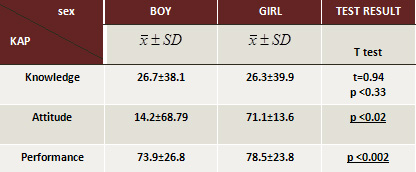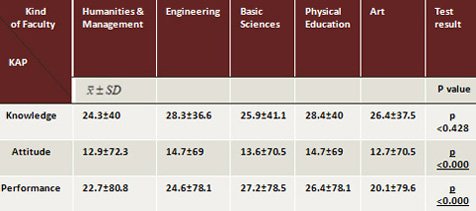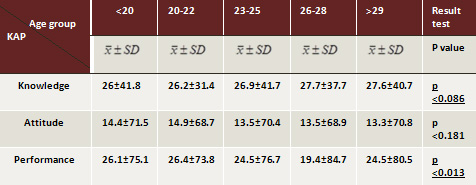| |
March
2016
- Volume 10, Issue 1
Knowledge, attitude, and performance towards crack abuse side
effects according to the students gender and kind of faculty

|
 ( (
|
Maryam Nooritajer
Correspondence:
Associate Professor
Islamic Azad University;
Islamshahr Branch
Iran
Email: maryamnoorytajer@yahoo.com
|
 |
|
Abstract
Introduction: Today, Substance Abuse is one of
the most important problems in the world, which is known
as an ominous and ruinous crisis that can increase human
mortality rate all over the world. Crack abuse is nowadays
considered the leading cause of consulting withdrawal
institutes, which reveals the increasing addiction rate
with this high-risk substance in Iran.
This study design was based on a cross -sectional method
and the main aim is to determine the Knowledge, attitude,
and performance towards crack abuse side effects according
the students gender and pertinent faculty.
Methods: The present descriptive and analytical
research Knowledge, attitude, and performance towards
crack abuse side effects according to the students gender
and the research population (n = 906) consisted of all
the students from different faculties of Islamic Azad
University, Islamshahr Branch and were selected using
the stratified sampling method and were allocated to
respective groups according to gender. The data collection
tool was a questionnaire. The research data were analyzed
using the t-test, and also Chi-square and ANOVA tests
and the Pearson correlation coefficient.
Result: Data related to the measurement of the
students 'knowledge , attitude, and performance regarding
the short-term and long-term crack abuse side effects
are shown in Tables 1, 2, 3, and 4. The results obtained
revealed that students' needs assessment towards crack
abuse side effects at three levels, namely their knowledge,
attitude and performance were lower than 50%; such that
58.2% had a low-level knowledge, 55.5% had a negative
attitude, and 49% of them had an unfavorable performance
level.
Conclusion: The findings related to the comparison
of the mean male and female students' knowledge , attitude,
and performance regarding crack abuse side effects revealed
a statistically significant correlation at the areas
of attitude and performance; also a statistically significant
correlation was observed between gender and attitude
(mean attitude among females and males was 71.10 and
68.97, respectively) and between gender and performance
(mean performance among females and males was 78.5 and
73.9, respectively), i.e. attitude and performance was
higher among females.
(P < 0.000 in all cases).
Key words: Knowledge, attitude, performance,
crack abuse, side effects, students' gender, kind of
faculty
|
Introduction
Today, Substance Abuse is one of the most important problems
in the world, and is known as an ominous and ruinous crisis
that can increase human mortality rate all over the world.
Crack abuse is nowadays considered the leading cause of consulting
withdrawal institutes, which reveals the increasing addiction
rate with this high-risk substance in Iran. Addiction has
also caused many social problems in Iran. Several important
socio-economic events such as a petroleum-related economy,
the 8-year war against Iraq, population overgrowth, expanding
global communicative technology, increased expectations of
the young generation, the trend of industrial development
and the related complications such as immigration and unemployment,
are all issues that make the Iranian society more vulnerable
to addiction (1).
Nearly 11% of the young substance abusers in Iran don't believe
these substances cause addiction (2), and the satisfaction
achieved after abuse often causes tendency for continuous
abuse. Therefore, neglecting the accelerated widespread prevalence
of substance abuse and the related complications among the
student population; and the production of laboratory synthetic
substances such as crack, ecstasy, and crystal (suggesting
an impending and widespread threat) on one hand, and the lack
of related research, reliable and basic statistical data;
unknown motives, methods, patterns, and prevalence of substance
abuse among students; unknown relationship between substance
abuse and problematic situations (such as motiveless and decreased
efficacy of learning, living away from family members, living
in dormitories, organic and mental illnesses, feeling loss
of identity, and promiscuous sexual behavior) on the other
hand (3), reveals the necessity of intervention by different
social groups (especially health care professionals), as they
can play an important role in formulating educational programs;
and as the first step in formulating an educational program
is determining students' needs assessment, the most effective
approach for determining an appropriate educational content
is needs-analysis. Therefore, coordination between educational
programs and needs assessment is
an important issue that needs to be considered. Thus, the
researchers aimed at determining students' needs assessment
towards crack abuse side effects in order to provide a perspective
of the current situation for authorities in the area of addiction
and to take a step forward in decreasing the tendency of the
Iranian young population towards this internecine disaster.
Materials &
Methods
The present descriptive and analytical research Knowledge,
attitude, and performance towards crack abuse side effects
according to the students' gender and the research population
(n = 906) consisted of all the students from different faculties
of Islamic Azad University, Islamshahr Branch and were selected
using the stratified sampling method and were allocated to
respective groups according to gender. The data collection
tool was a questionnaire. The research data were analyzed
using the t-test, and also Chi-square and ANOVA tests and
the Pearson correlation coefficient.
Result
Result of the subjects, who were 18-35 years old; 40.2% were
female and 542 were male. The results obtained revealed that
towards crack abuse side effects at three levels, namely their
knowledge, attitude, and performance were lower than 50%;
such that 58.2% had a low-level knowledge , 55.5% had a negative
attitude, and 49% of them had an unfavorable performance level.
33.1, 33.9, 11.5, 10.7, and 10.5 percent of the subjects were
selected from the Humanities & Management faculty, the
Engineering faculty, the Basic Sciences faculty, the Physical
Education faculty, and the Art faculty.
Data related to the measurement of the students 'knowledge
, attitude, and performance' regarding the short-term and
long-term crack abuse side effects are shown in Tables 1,
2, and 3. The results obtained revealed that students' needs
assessment towards crack abuse side effects at three levels,
namely their knowledge, attitude, and performance were lower
than 50%; such that 58.2% had a low-level knowledge , 55.5%
had a negative attitude, and 49% of them had an unfavorable
performance level.
Table 1: comparison of Mean and
standard deviation students' knowledge, attitude, and performance
towards crack abuse side effects in Islamic Azad University;
Islamshahr Branch according to Sex

Table 2: comparison of Mean and standard deviation students'
knowledge ,attitude, and performance towards crack abuse side
effects in Islamic Azad University; Islamshahr Branch according
to kind of faculty

Table 3: comparison of Mean and standard deviation students'
knowledge, attitude , and performance towards crack abuse
side effects in Islamic Azad University; Islamshahr Branch
according to Age

The findings related to the comparison of the mean male and
female students' awareness, attitude, and function regarding
crack abuse side effects revealed a statistically significant
correlation at the areas of attitude and function, such that
a statistically significant correlation was not observed between
gender and awareness regarding crack abuse side effects (mean
awareness among females and males was 39.9 and 38.19, respectively);
but a statistically significant correlation was observed between
gender and attitude (mean attitude among females and males
was 71.10 and 68.97, respectively) and also between gender
and function (mean function among females and males was 78.5
and 73.9, respectively), i.e. attitude and function was higher
among females. Accordingly, the findings of Torabi, Mohammad
revealed a statistically significant correlation between gender
and smoking (4), and the results of research performed by
Zia-Eddini showed that 26.5% of the males and 11.5% of the
females had a positive history of substance abuse on at least
one occasion, which were consistent with the results of our
study (5).
The findings regarding needs assessment towards crack abuse
side effects and the pertinent faculty revealed a statistically
significant correlation at the areas of attitude and function,
such that the students of the Engineering faculty and the
Physical Education faculty had the least and the most awareness
levels (means = 36.67 and 40.05, respectively); in addition,
the students of the Engineering faculty and the Humanities
faculty had the least and the most attitude levels (means
= 67.18 and 73.38, respectively); also, the students of the
Engineering faculty and the Humanities faculty had the least
and the most function levels (means = 80.88 and 67.9, respectively.
The variance analysis test showed a statistically significant
correlation between age and function, and the highest needs
assessment regarding awareness was observed among students
under 20 years old (mean = 41.8), and the highest attitude
revealed a mean of 80.5, although the highest performance
was observed among the students over 30 years old. The results
of research performed by Shafigh, Madjid revealed that male
gender is considered a risk factor for substance abuse among
the medical students in Pakistan (6).
In addition, the 26-28 year old and the 20-22 year old subjects
had the best and the worst function levels (means = 84.7 and
73.84, respectively); students under 20 years of age revealed
the lowest attitude level (mean = 71.52). The results of research
performed by Kumar revealed that substance abuse (especially
in combination form) has increased among the medical students,
especially among the male students, and that the long duration
of education affects substance abuse (7).
Conclusion
The results of the present research regarding students' needs
assessment towards short-term and long-term crack abuse side
effects revealed that short-term awareness trends toward low-level
as compared to long-term awareness; students' long-term attitude
towards crack abuse side effects trends towards negative.
Generally, students' needs assessment towards short-term and
long-term crack abuse side effects was at the high level,
but rendering needs assessment towards short-term crack abuse
side effects had a higher priority, i.e. their needs assessment
is primarily based on short-term; in addition, students' needs
assessment regarding long-term function trend towards unfavorable.
References:
1-Micheli D, Formigoni M.L. (2004). Drug use by Brazilian
students: association with family, psychosocial, health, demographic
and behavioral characteristics. Addiction, 99. 570-578
2- crack. (2009, may). Retrieved 2009, from dadkhah: www.dadkhahi.net/wiki//index.php
Prevalence of consumption of crack injection in the country.
(2009, may 16). Retrieved 2009, from tabnak: www.tabnak.ir/pages/?cid=10185
3- Mohler-Kuo M, Lee JE, Wechsler H. Trends in marijuana and
other illicit drug use among college students: results from
4 Harvard School of Public Health College Alcohol Study surveys:
1993-2001. J Am Coll Health. 2003,Jul-Aug;52(1):17-24.
4-Torabi M, Yang J, Li J. (2002). Comparison of tobacco use
knowledge, attitude and practice among college students in
China and the United Stat. Health Promotion Internationa,
17(3), 247-253.
5- Zia-Eddini, Zarezadeh A., H. F. (2007). Drug and alcohol
abuse and addiction related factors in senior year and college
students in Kerman Sal80-1379. Journal of Kerman University
of Medical Sciences, No. 2, 94-84.
6- Rahimi S, Yavari HR, Shahi S, Zand V, Shakoui S, Reyhani
MF, Pirzadeh A.. (2010;52(1):77-81) Comparison of the effect
of Er, Cr-YSGG laser and ultrasonic retrograde root-end cavity
preparation on the integrity of root apices. J Oral Sci, 52(1):77-81.
7-- Kumar P, Basu D. (2000). Substance abuse by medical students
and doctors. J Indian Med Assoc, 98(8):447-52.
|
 |




